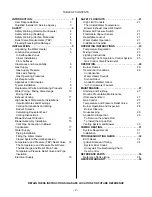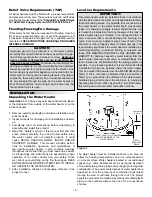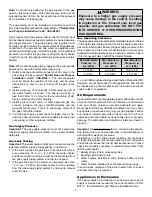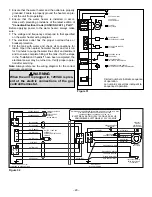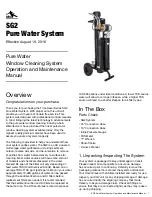
Note:
An odourant is added by the gas supplier to the gas
used by this water heater. This odourant may fade over an
extended period of time. Do not depend upon this odourant
as an indication of leaking gas.
This gas piping must be installed in accordance with all
provincial requirements and the latest edition of
"Natural Gas
and Propane Installation Code" CSA-B149.1
.
Use properly sized gas piping and to ensure full gas input
and a properly sized gas supply regulator to ensure adequate
gas supply pressure. The supply piping and regulator must
be large enough to satisfy the requirements of all appliances
connected to the gas service and when all appliances are
operating simultaneously. Undersize piping and insuf
fi
cient
pressure can restrict the gas
fl
ow causing the water heater
to perform poorly. Improperly sized piping may pose a safety
hazard.
Note:
When installing gas piping, apply sealing compounds
approved for use with natural and propane gas.
Install a readily accessible manual shut-off valve in the
gas supply line as required
"Natural Gas and Propane
Installation Code" CSA-B149.1
. The owner/operator
must be shown the location of this valve and be given
instructions on how to use it to shut off the gas to the
heater.
Install a drip leg (if not already incorporated as part of
the water heater) as shown. The drip leg must be no
less than 76mm (3 in.) long for the accumulation of dirt,
foreign material, and water droplets.
Install a ground joint union, or other approved gas dis-
connect, between the gas control/thermostat and the
manual shut-off valve. This is to allow easy removal of
the gas control/thermostat.
Turn the gas supply on and check for leaks. Use a chlo-
ride-free soap and water solution (bubbles forming indi-
cate a leak) or other approved method.
Gas Supply Pressure
Important:
The gas supply pressure must not exceed the
maximum supply pressure as stated on the water heater's
data plate.
Gas Leak Testing
Important:
This water heater and its gas connection must be
leak tested before placing the appliance in operation.
If the code requires the gas lines to be tested at a pres-
sure exceeding 14 in. w.c. (3.5 kPa), the water heater
and its manual shut-off valve must be disconnected from
the gas supply piping system and the line capped.
If the gas lines are to be tested at a pressure less than
14 in. w.c. (3.5 kPa), the water heater must be isolated
from the gas supply piping system by closing its manual
shut-off valve.
1.
2.
3.
4.
•
•
WARNING
Exposure to a higher gas supply pressure
may cause damage to the control, resulting
in explosion or
fi
re. Consult your local gas
supplier and gas authorities. DO NOT PUT
INTO SERVICE IF OVER-PRESSURIZATION
HAS OCCURRED.
Gas Operating Pressures
The gas supply pressure and burner manifold pressure is listed
on the data plate located on the front of the heater above the
gas control/thermostat. Ensure the gas supply pressure to the
water heater and the burner manifold pressure are properly
adjusted while all appliances are in operation. Refer to Figure
35 for Honeywell Gas Control/Thermostat Details.
Rated Manifold
Pressure. in.
w.c. (kPa)
Min. Manifold
Pressure. in.
w.c. (kPa)
Max. Manifold
Pressure. in.
w.c. (kPa)
10 (2.48)
9.2 (2.28)
10.2 (2.53)
4 (0.99)
3.6 (0.89)
4.4 (1.09)
U.L. and CSA recognized fuel gas and Carbon Monoxide (CO)
detectors are recommended in all applications and should
be installed using the manufacturer's instructions and local
codes, rules or regulations.
Air Requirements
A gas water heater cannot operate properly without the correct
amount of air for combustion. Do not install in a con
fi
ned area
such as a closet, unless you provide adequate air supply.
Never obstruct the
fl
ow of dilution/ventilation air. If you have
any doubts or questions at all, call your gas supplier. Failure
to provide the proper amounts of air can result in a
fi
re or
explosion and cause death, serious bodily injury, or property
damage. The combustion and dilution air inlets are shown in
Figure 5.
Important:
Air must not come from a corrosive atmosphere.
Any failure due to corrosive elements in the atmosphere is
excluded from warranty coverage.
Installations in or for certain places including, but not limited
to, those listed below may require outdoor air for combustion
and dilution to reduce the risk of chemical exposure. In these
cases it is probably necessary to install a Power Direct Vent
(PDV) water heater:
Beauty shops, Photo processing labs
Buildings with indoor pools
Water heaters installed in some laundry, hobby or craft
rooms
Water heaters installed near chemical storage areas
In some cases, isolation of the water heater from corrosive
environments may be required.
Appliances In Enclosures
If the water heater is installed in an enclosure ensure an air
supply is provided as required by the current edition of CSA-
B149.1, the Natural Gas and Propane Installation Code.
•
•
•
•
– 7 –


